The Powell Gardens' landscape will near its peak of spring this weekend, the earliest since 1987 from gardener's recollections--certainly the earliest in the 16 springs I have lived here. The Daffodils/Narcissus have been simply spectacular and the early flowering trees have been a breath of fresh springtime colors dancing across the gardens. The Heartland Harvest Garden's peach trees were simply a great joy to witness and we photo documented the entire collection because each variety has flowers that are either showy or not so much. This information is valuable to edible landscapes that want to balance beauty and productivity!
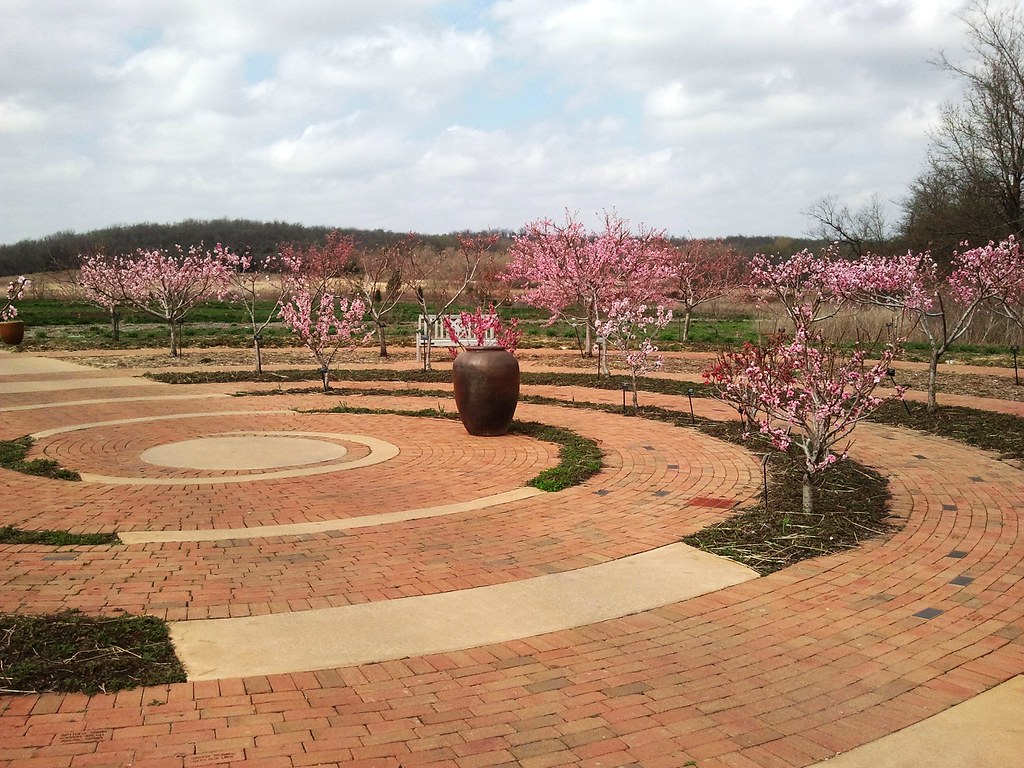
Here is the Peach Court in the Heartland Harvest Garden with its collection of almost 30 varieties of Peaches (Prunus persica and Nectarines var. nectarina). A few of the best cultivars are repeated on different rootstocks, smaller "semi-dwarf" rootstock closer in on the spiral and on "standard" rootstock where they will grow larger to full size on the outer ring of this garden.
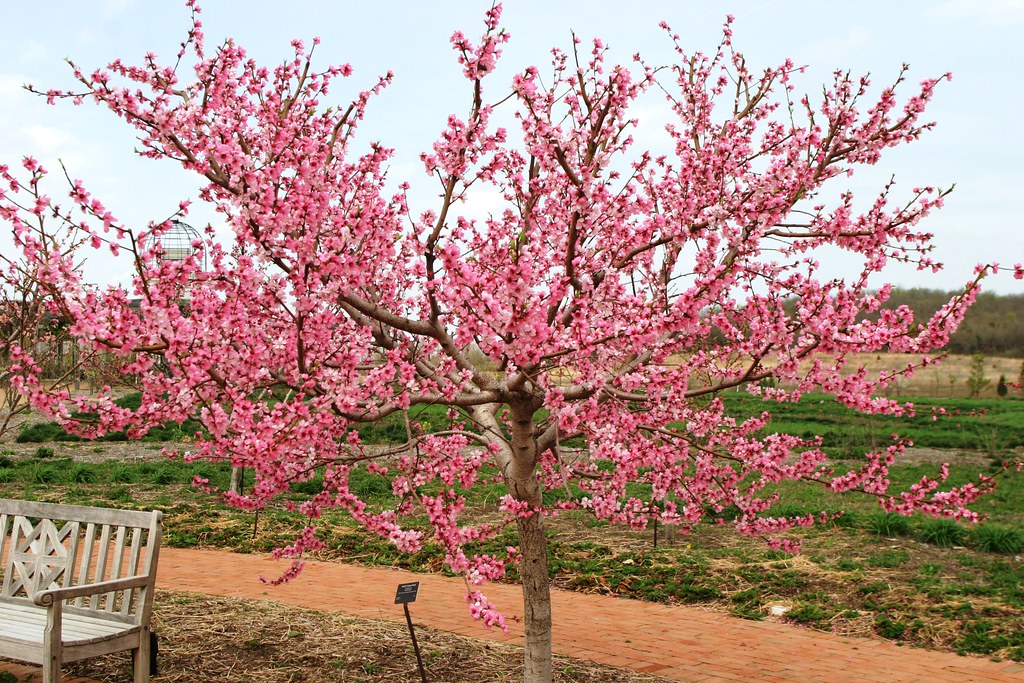
This a Stark 'Saturn' Peach which has some of the showiest, rosy-pink flowers. 17 of the Peach and Nectarine varieties have similar showy, rosy-pink flowers. Saturn Peach is a flat "doughnut" peach from Northern China that does very well in our climate and the peaches are funny looking but delicious!
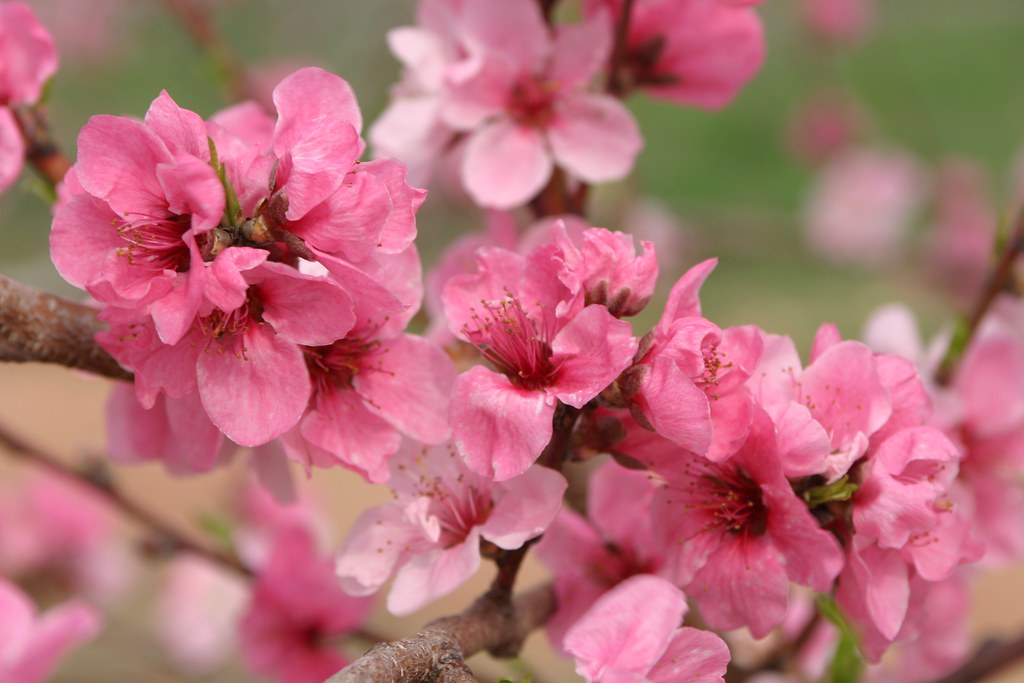
Here's a closeup of a 'Stark CrimsonGold' Nectarine that fits the category of beautiful, showy-flowering peaches and nectarines.
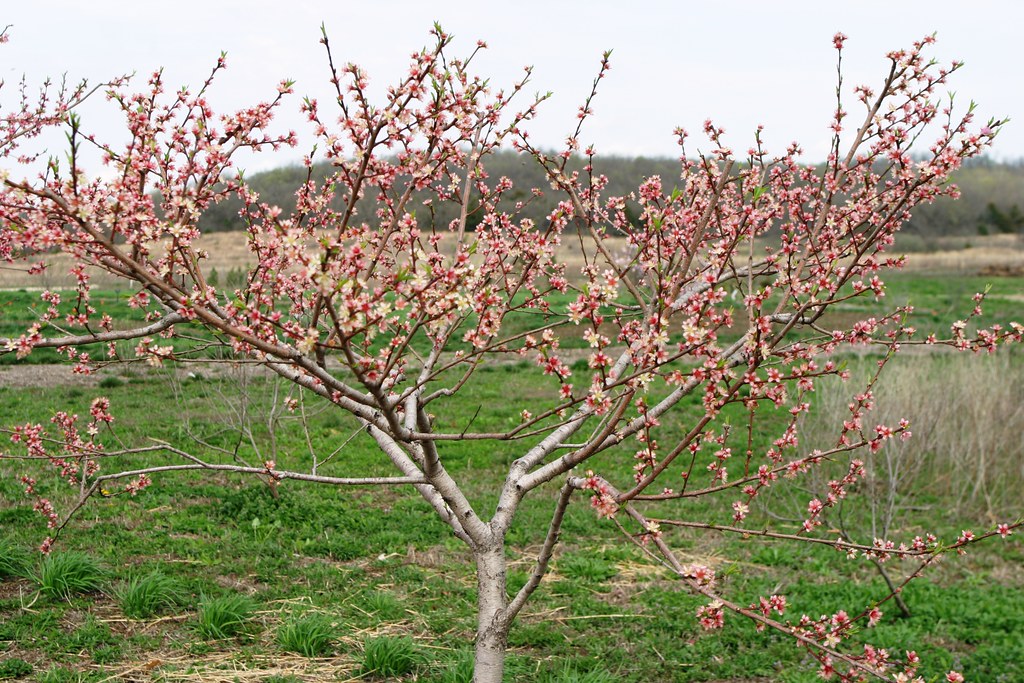
This is the classic Missouri 'Redhaven' Peach which you can see has much smaller, carmine pink flowers that are much less showy in the landscape. We still recommend this variety for its superior peaches but in an edible landscape it looks even better mixed or paired with the showier flowering varieties.

Here's a closeup of 'Reliance' Peach which depicts a variety with less showy, carmine pink flowers. I actually split the less showy varieties into two groups: 11 with less showy carmine pink blooms (which included 'Reliance') and 10 varieties with the least showy carmine pink flowers (which included 'Redhaven' above). Most of the hardiest peaches with both extreme cold and frost tolerance have the less showy type flowers but 'Saturn' is an exception to that rule.

A very few peaches and peach hybrids have beautiful, showy soft pink flowers. This is our "Wilbur Kephart Indian" Peach, which is a family heirloom that was brought from Tennessee where Wilbur's forefathers found it growing wild (Wilbur is an 80-something local farmer, historian and Powell Gardens volunteer). Peaches are actually from China but traveled to Europe on the Silk Road, then via the Spaniards to the New World. The Native Americans quickly adopted the plant and spread it northward into Tennessee where it was already growing by the time settlers arrived. Think of the journeys this plant made!

The "Hardy" Almonds also have this beautiful soft pink bloom. This is the 'Reliable' Almond (Prunus x amygdalo-persica) which gets its hardiness from peaches as it is actually a peach-almond cross. It does produce dry fuzzy fruit with edible almonds in the pits. DO NOT EAT THE PITS OF REGULAR PEACHES as they are poisonous. True Almonds (Prunus dulcis) have white flowers and we have several new varieties hybridized in Russia that are doing well. Look for both 'Reliable' and 'Hall's Hardy' Almonds in our Vineyard.
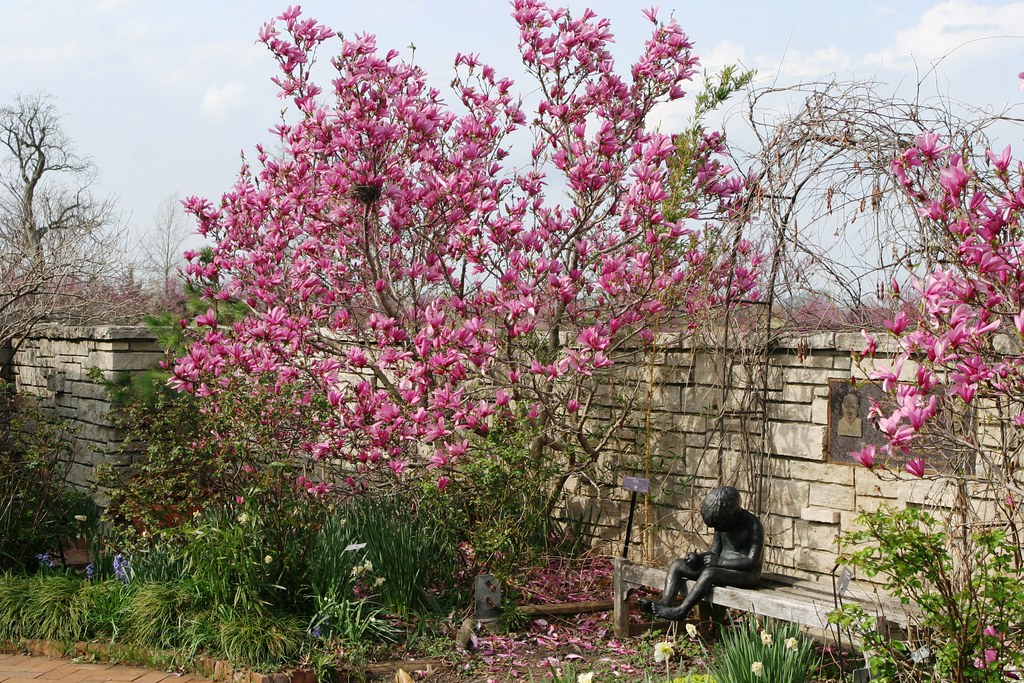
The mid season Magnolias are currently in full bloom throughout the gardens. Here is Ann Magnolia in full bloom in the Courtyard on the north side of the Visitor Center with a sculpture by the late Mary Kay Powell on the bench below the Powell Memorial plaque. Ann is one of the "Little Girl" Magnolias bred at the National Arboretum as hybrid crosses between Star and Lily Magnolias in an effort to get the frost resistance of Star Magnolia and the later bloom of Lily Magnolia. The best ones are named and we have 'Betty,' 'Jane,' 'Pinkie' and 'Randy' in other parts of the garden.
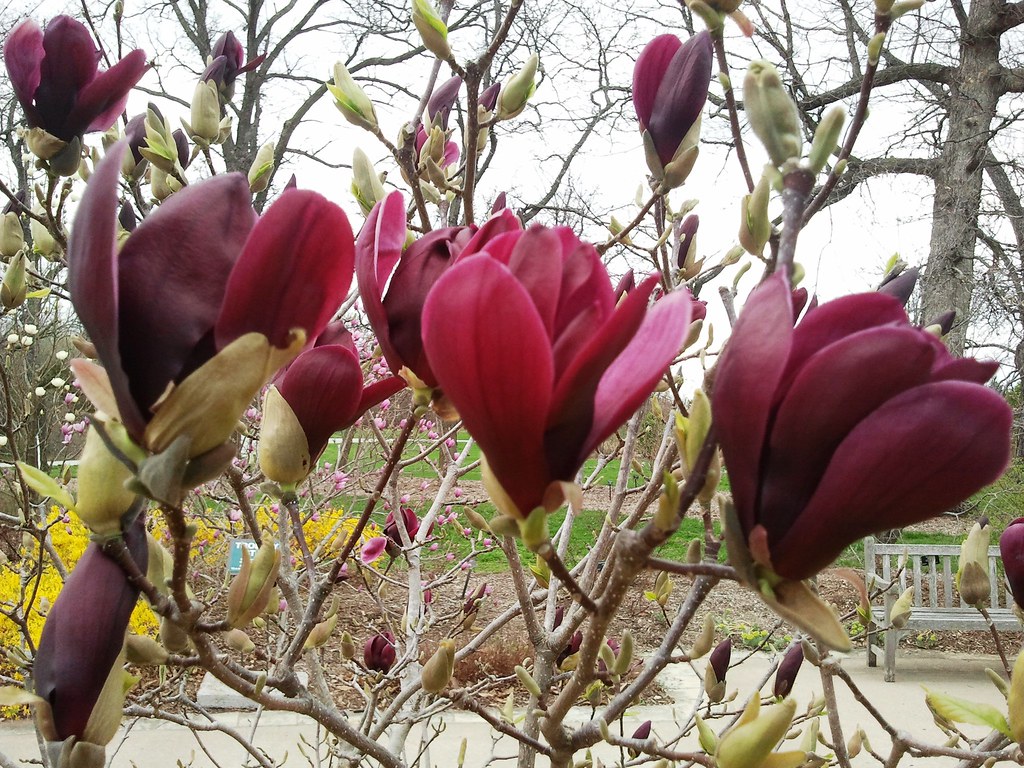
Here are the darkest flowering magnolias currently in bloom at the garden. This is the 'O'Neill' Lily Magnolia (Magnolia liliiflora) growing by the Visitor Center trolley stop. WOW is it vivid this year and seems to be deeper colored the warmer it is. Most varieties are just the opposite and are paler in warmer weather.
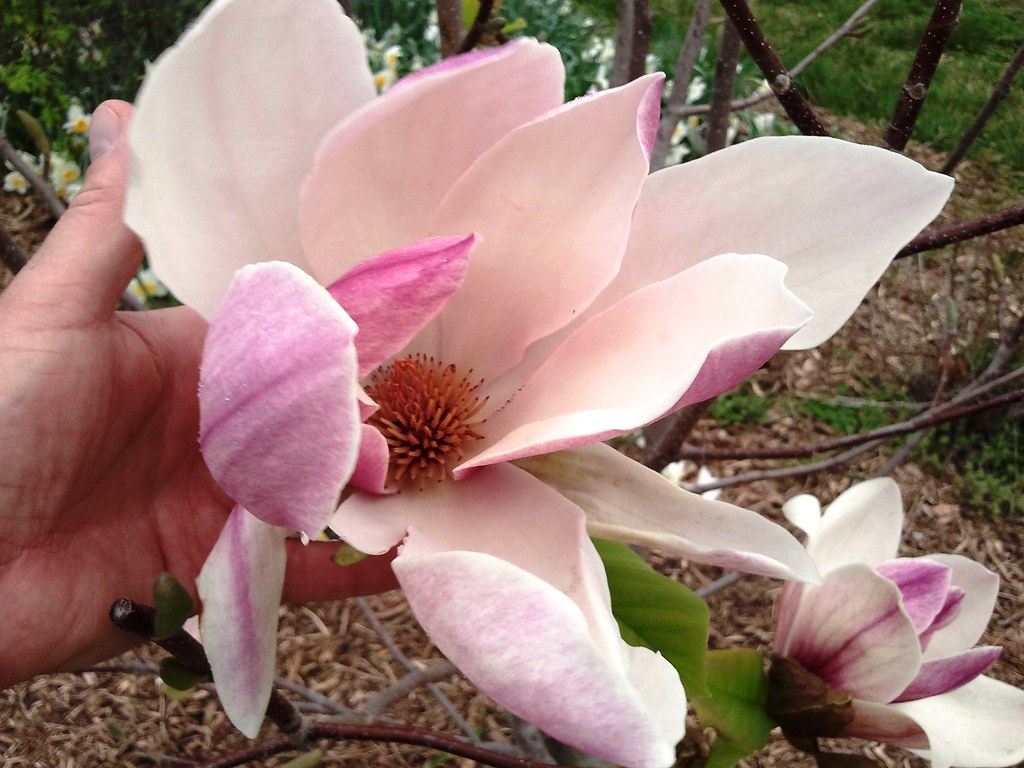
Look at this spectacular Magnolia blossom! This is a new cultivar called 'Toro' and is a hybrid with Missouri native Cucumbertree (Magnolia acuminata). It has HUGE flowers and is very hardy through zone 4. Look for Toro Magnolia blooming on the east edge of the Perennial Garden along the path to the Trigg Building.

Our native woodland wildlfowers are also making their graceful appearance. Linda Williams took this picture of White Trout-lily (Erythronium albidum) during the nature hike on Sunday on the Byron Shutz Nature Trail. Actually the best woodland wildflowers are along the first portion of that trail in the oak-hickory woods and include Spring Beauty, Toad Trillium, and Virginia Bluebells. Our showiest native tree is also going to be in full bloom this weekend: REDBUDS!!! They normally bloom about April 10th here but opened on March 19th out here this year. Come see them and all the other floral surprises of spring now in store for you at Powell Gardens.
Last weekend's tours of the Magnolia collections hit the peak of spring bloom on the early-mid "precocious" (blooming before the leaves) varieties but the mid-season varieties will be in peak flower for this weekend.
Wednesday, March 21, 2012
A Peachy Keen Landscape
Posted by
Kansas City's botanical garden
at
10:39 AM
0
comments
![]()
![]()
Labels: magnolias, peaches, spring flowers, wildflowers
Tuesday, April 22, 2008
The Precocious Magnolias of Powell Gardens
Powell Gardens has one of the most extensive public garden collections of magnolias outside the East and West Coasts. The magnolias that bloom before the leaves emerge are known as "precocious" magnolias. All have native origins in Eastern Asia where the Yulan (Magnolia denudata) is widely attributed as being the first plant ever cultivated by humankind for its beauty rather than its food value. We have planted a Yulan just before you enter our new Heartland Harvest Garden just for that contrast! Native American magnolias bloom later in spring and into early summer -- an adaptation to North America's wild mood swings of spring weather. The American Cucumber Magnolia (Magnolia acuminata) the only magnolia with yellow in its flowers has been hybridized with the Asian precocious magnolias to create some of the new precocious yellow-flowering cultivars. This was first done by the Brooklyn Botanical Garden.
Magnolia 'Gold Cup' is a hybrid between the Yulan and American Cucumbertree Magnolia. It's huge goblet flowers have a yellowish base but I would have named this plant 'Ivory Cup'! This plant is currently in bloom at the Visitor Center Trolley Stop.
Magnolia 'Butterflies' is probably the most yellow of the precocious hybrid magnolias. It is becoming more widely available in the nursery trade and always a stunning bloomer at Powell Gardens -- it has never failed to bloom! Its only drawback is that a small tree takes about six years to be covered in flowers. (The backdrop magnolia is Magnolia 'Royal Crown.')
The open flowers of Butterflies Magnolia are like yellow waterlilies. Our largest plant is at the Visitor Center Trolley Stop.
Magnolia 'Royal Crown' has huge 10-inch blooms. It usually begins to bloom in late February and is subsequently ruined by frosts and freezes. This year it held off to bloom spectacularly BUT we grow it for its secondary bloom in June. The June bloom is awesome with huge pink, better formed flowers set against the green foliage. This tree grows next to Butterflies at the trolley stop.
Magnolia 'March 'til Frost' has dark goblet shaped flowers and blooms fully in March (April this year!) and sporadically all through the season until fall's frost. This tree is also at the Visitor Center Trolley Stop.
The common Saucer Magnolia (Magnolia x soulangiana) has several exquisite cultivars that are hard to find and usually just available mailorder from specialty nurseries. This is the fabulous cultivar 'Lennei Alba' with its exquisitely formed, pristine flowers.
Rustica Rubra Saucer Magnolia is another fabulous cultivar with deeper, better formed flowers with good repeat bloom through the season. We planted it around the front of the Kauffman Garden's orangerie. Colonial Nursery has nice balled and burlaped plants of this beauty this year.
The "Little Girl" magnolias are becoming immensely popular and combine the purple color of the Chinese Lily Magnolia (Magnolia liliiflora) with the frost hardy, Japanese Star Magnolia (Magnolia stellata). The combination is sterile but it has flower power with frost tolerant, later bloom and good repeat bloom in the summer. Jane Magnolia is depicted and is the most like the saucer magnolia. It is also the most widely available of the "Little Girls."
Ann Magnolia is a good bushy cultivar of the "Little Girls." It has orchid pink flowers in abundance and can be seen in the Visitor Center's Courtyard. This cultivar is widely available at local nurseries.
Pinkie Magnolia is my favorite of the "Little Girls" with the best formed, best color in my mind. You can see it next to 'Butterflies' magnolia on the Trolley Stop. It is very difficult to find and usually available only mailorder.
Randy Magnolia is another one of the "Little Girls" that is now difficult to find. I like it here in the Rock & Waterfall Garden where shady conditions favor it to have less, more widely spaced blooms that are so showy now. The Little Girls will grow in full sun to shade but have more blossoms in the sun.
The Northern Kobus Magnolia (Magnolia kobus 'Borealis') was a cloud of white flowers. This is probably the largest growing of the precocious magnolias and is found wild on Japan's north island of Hokkaido. It can easily grow to 50 feet tall! Wendy Powell just sent me some images from the Brooklyn Botanical Garden showing many of their mature magnolias in bloom. Powell Gardens has set the stage for spectacular displays of spring flowering magnolias for years to come! This is but a small taste of the 90 cultivars on display at Powell Gardens, though as a young garden our plants are still small.
Posted by
Kansas City's botanical garden
at
8:28 AM
0
comments
![]()
![]()
Labels: magnolias, spring flowers, trees
Thursday, April 10, 2008
Daffodils and Magnolias
The Daffodils a.k.a. Narcissus are blooming in colorful drifts of cream to yellow and orange throughout Powell Gardens. If you have not been to Powell Gardens in a while we have planted more than 100,000 more bulbs in the past couple seasons. The early magnolias are also in full bloom -- foliated in fragrant flowers of blush pink and white.
Posted by
Kansas City's botanical garden
at
8:37 AM
0
comments
![]()
![]()


















